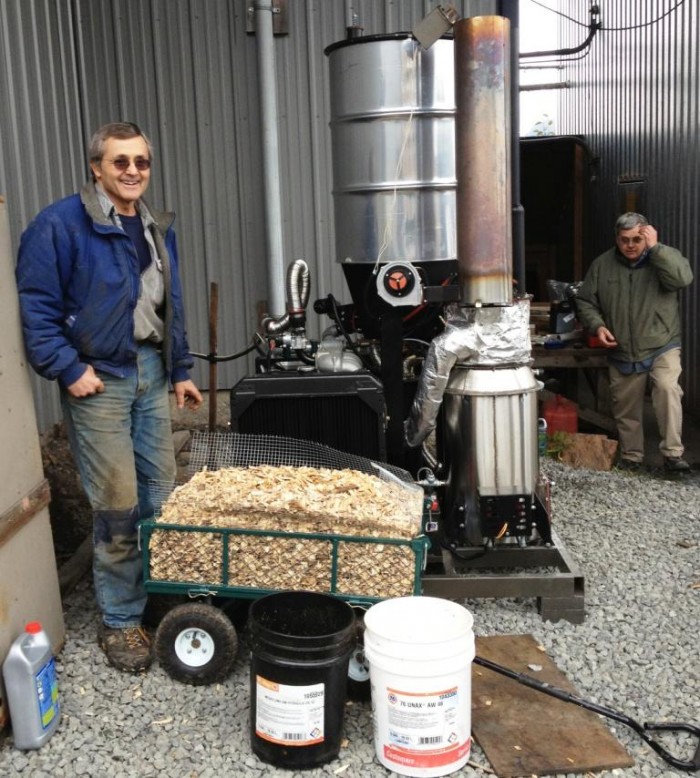
Wes and Sue Tyler run Icy Straits Lumber & Milling in Hoonah, about 40 miles west of Juneau. They make log cabin kits, siding, beams and other finished products out of Southeast Alaska wood.
But high energy prices have increased operating costs. A particular problem is equipment used to dry damp wood.
So Wes watched closely as a new system using wood chips to generate electricity was turned on earlier this month.
“All of a sudden the engine comes to life and we’re able to go in and turn on all the lights in the building and a fan that was pushing some warm air around in the dry kiln and with a few more KWs involved, why you could ultimately have the dry kiln running on that sort of fuel,” Tyler says.
The system is called wood gasification.
It’s part of an experiment to see if compact devices – this one is 4 by 4 by 8 feet high – are a viable alternative to oil-powered systems.
So far, the generator at the Tylers’ has been working fine.
Sealaska Executive Vice President Rick Harris, speaking at a press briefing in Juneau, says Icy Straits Lumber is the right place to try it out.
“He’s already got the wood supply there. He has the technical know-how to deal with these kinds of things. But based upon his experience then we can see if we can transfer this type of technology to other areas,” Harris says.
In fact, a second unit is also being tested at the mill, for eventual use at a Hoonah tourist attraction.
Wood gasification is not new technology. It’s been around, in one form or another, since the late 1800s. Small gasifiers were even used to power cars, trucks and trains in German-occupied territory during World War II fuel shortages.
How they work is not that complicated.
“So what we do in a gasifier is burn part of the wood and generate heat, which converts the solid to a gas,” says consultant Tom Miles of Portland. He worked with Sealaska’s Haa Aaní subsidiary and Icy Straits Lumber to select and install this particular system.
“And then the mixture of the gas with charcoal solids further reduces the fuel to a fuel gas. And the fuel gas is about half nitrogen, about 20 percent carbon monoxide, and about 20 percent hydrogen. And that will burn in an internal combustion engine,” Miles says.

It’s not as efficient as gasoline or propane. And it won’t replace hydropower. But if wood scraps or leftovers from milling or thinning trees are easily available, it can be cheaper.
Miles says it can take about a third off the cost of a diesel-powered generation. (Read more about wood gasifiers.)
“We will be not only generating electricity but we can capture waste heat from the engines so it’s micro-scale combined heat and power [system],” he says.
Sealaska’s Harris says a Hoonah lodge-owner has already shown interest in the system.
And the corporation is working with the Icy Strait Point tourist attraction, which is owned by Hoonah’s village Native corporation, to use gasification to power and heat a cultural center, and eventually, a greenhouse.
“It’s one of those things where in the summer they have a lot of visitors come in. So we can grow in the greenhouse certain plants and vegetables that they can use. And then in the winter when they’re not using it, we can move that stuff into the Juneau market or the local market,” Harris says.
Sealaska and its consultant have looked at a lot of gasification options. Harris says the Hoonah experiments will show whether they chose the right technology.
“In a month, Wes may tell us this just isn’t going to work. I think we’re fairly optimistic that it will work. But that’s why we’re doing it in a place where we have the ability to make the necessary adjustments and to prove it can work in a rural community environment,” he says.
Sealaska’s energy experiments have been funded in part by the federal Department of Energy and other sources.
It’s already heating its Juneau headquarters with a wood-pellet boiler, which is cheaper than diesel heat. It also considered building a waste-wood ethanol plant at Ketchikan’s Ward Cove, but concluded it wasn’t economically feasible.
Leave a Reply
You must be logged in to post a comment.